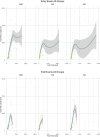Virtual reality simulation training in laparoscopic surgery - does it really matter, what simulator to use? Results of a cross-sectional study
- PMID: 38807093
- PMCID: PMC11134658
- DOI: 10.1186/s12909-024-05574-0
Virtual reality simulation training in laparoscopic surgery - does it really matter, what simulator to use? Results of a cross-sectional study
Abstract
Background: Virtual reality simulation training plays a crucial role in modern surgical training, as it facilitates trainees to carry out surgical procedures or parts of it without the need for training "on the patient". However, there are no data comparing different commercially available high-end virtual reality simulators.
Methods: Trainees of an international gastrointestinal surgery workshop practiced in different sequences on LaparoS® (VirtaMed), LapSim® (Surgical Science) and LapMentor III® (Simbionix) eight comparable exercises, training the same basic laparoscopic skills. Simulator based metrics were compared between an entrance and exit examination.
Results: All trainees significantly improved their basic laparoscopic skills performance, regardless of the sequence in which they used the three simulators. Median path length was initially 830 cm and 463 cm on the exit examination (p < 0.001), median time taken improved from 305 to 167 s (p < 0.001).
Conclusions: All Simulators trained efficiently the same basic surgery skills, regardless of the sequence or simulator used. Virtual reality simulation training, regardless of the simulator used, should be incorporated in all surgical training programs. To enhance comparability across different types of simulators, standardized outcome metrics should be implemented.
Keywords: Laparoscopic Training; Simulation; Surgical Education; Surgical Training; Virtual Reality Training.
© 2024. The Author(s).
Conflict of interest statement
The authors declare no competing interests.
Figures
References
MeSH terms
LinkOut - more resources
Full Text Sources



